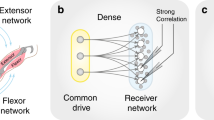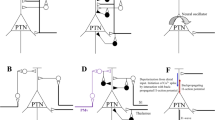Abstract
Spinal recurrent inhibition linking skeleto- motoneurons (α-MNs) via Renshaw cells (RCs) has been variously proposed to increase or decrease tendencies toward synchronous discharges between α-MNs. This controversy is not easy to settle experimentally in animal or human paradigms because RCs receive, in addition to excitatory input from α-MNs, many other modulating influences which may change their mode of operation. Computer simulations help to artificially isolate the recurrent inhibitory circuit and thus to study its effects on α-MN synchronization under conditions not achievable in natural experiments. We present here such a study which was designed to specifically test the following hypothesis. Since many α-MNs excite any particular Renshaw cell, which in turn inhibits many α-MNs, this convergence–divergence pattern establishes a random network whose random discharge patterns inject uncorrelated noise into α-MNs, and this noise counteracts any synchronization potentially arising from other sources, e.g., common inputs (Adam et al. in Biol Cybern 29:229–235, 1978). We investigated the short-term synchronization of α-MNs with two types of excitatory input signals to α-MNs (random and sinusoidally modulated random patterns). The main results showed that, while recurrent inhibitory inputs to different α-MNs were indeed different, recurrent inhibition (1) exerted rather small effects on the modulation of α-MN discharge, (2) tended to increase the short-term synchronization of α-MN discharge, and (3) did not generate secondary peaks in α-MN-α-MN cross-correlograms associated with α-MN rhythmicity.
Similar content being viewed by others
References
Adam D, Windhorst U, Inbar GF (1978) The effects of recurrent inhibition on the cross correlated firing patterns of motoneurones (and their relation to signal transmission in the spinal cord muscle channel). Biol Cybern 29:229–235
Ashby P, Zilm D (1982) Characteristics of postsynaptic potentials in single human motoneurones by homonymous group I volleys. Exp Brain Res 47:41–48
Buahin KG, Rymer WZ (1984) Renshaw cell desynchronization of output. Soc Neurosci Abstr 10(Part 1):329
Christakos CN, Papadimitriou NA, Erimaki S (2006) Parallel neuronal mechanisms underlying physiological force tremor in steady muscle contractions of humans. J Neurophysiol 95:53–66
Christakos CN, Windhorst U, Rissing R, Meyer-Lohmann J (1987) response of spinal Renshaw cells activated by stochastic motor axon stimulation. Neuroscience 23:613–623
Davey NJ, Ellaway PH, Baker JR, Friedland CL (1993) Rhythmicity associated with a high degree of short-term synchrony of motor unit discharge in man. Exp Physiol 78:649–661
Dietz V, Bischofberger E, Wita C, Freund H-J (1976) Correlation between the discharges of two simultaneously recorded motor units and physiological tremor. EEG Clin Neurophysiol 40:97–105
Elble RJ, Randall JE (1976) Motor-unit activity responsible for 8 to 12-Hz component of human physiological finger tremor. J Neurophysiol 39:370-383
Farmer SF, Swash M, Ingram DA, Stephens JA (1993) Changes in unit synchronization following central nervous lesions in man. J Physiol 463:83–105
Gelfand IM, Gurfinkel VS, Kots YM, Tsetlin ML, Shik ML (1963) Synchronization of motor units and associated model concepts. Biofizika 8:475-486
Graham BP, Redman SJ (1993) Dynamic behaviour of a model of the muscle stretch reflex. Neural Netw 6:947–962
Hamm TM, Sasaki S, Stuart DG, Windhorst U, Yuan C-S (1987) The measurement of single motor axon recurrent inhibitory post synaptic potentials in the cat. J Physiol (Lond) 388:631–651
Harrison LM, Ironton R, Stephens JA (1991) Cross-correlation analysis of multi-unit EMG recordings in man. J Neurosci Meth 40:171–179
Kirkwood PA, Sears TA (1982) The effects of single afferent impulses on the probability of firing of external intercostal motoneurons in the cat. J Physiol (Lond) 322:315–336
Kirkwood PA, Sears TA, Stagg D, Westgaard RH (1982) The spatial distribution of synchronization of intercostal motoneurones in the cat. J Physiol (Lond) 327:137–155
Maltenfort MG, Heckman CJ, Rymer WZ (1998) Decorrelating actions of Renshaw interneurons on the firing of spinal motoneurons within a motor nucleus: a simulation study. J Neurophysiol 80:309–323
Mattei B, Schmied A, Mazzocchio R, Decchi B, Rossi A, Vedel J-P (2003) Pharmacologically induced enhancement of recurrent inhibition in humans: effects on motoneuron discharge patterns. J Physiol (Lond) 548(2):615–629
Stein RB, Oğuztöreli MN (1984) Modification of muscle responses by spinal circuitry. Neuroscience 11:231–240
Türker KS, Powers RK (2001) Effects of common excitatory and inhibitory inputs on motoneuron synchronization. J Neurophysiol 86:2807–2822
Uchiyama T, Johansson H, Windhorst U(2003) A model of the medial gastrocnemius motoneuron-muscle system subjected to recurrent inhibition. Biol Cybern 89:139–151
Windhorst U (1988) How brain like is the spinal cord? Interacting cell assemblies in the nervous system. Springer, Heidelberg
Windhorst U (1990) Activation of Renshaw cells. Prog Neurobiol 35:135–179
Windhorst U (1996) On the role of recurrent inhibitory feedback in motor control. Prog Neurobiol 49:517–587
Windhorst U, Kokkoroyiannis T (1992) Dynamic behaviour of α-motoneurones subjected to recurrent inhibition and reflex feedback via muscle spindles. Neuroscience 47:897–907
Windhorst U, Rissing R, Meyer-Lohmann J, Laouris Y, Kuipers U (1988) Facilitation and depression in the responses of spinal Renshaw cells to random stimulation of motor axons. J Neurophysiol 60:1638–1652
Author information
Authors and Affiliations
Corresponding author
Rights and permissions
About this article
Cite this article
Uchiyama, T., Windhorst, U. Effects of spinal recurrent inhibition on motoneuron short-term synchronization. Biol Cybern 96, 561–575 (2007). https://doi.org/10.1007/s00422-007-0151-7
Received:
Accepted:
Published:
Issue Date:
DOI: https://doi.org/10.1007/s00422-007-0151-7




